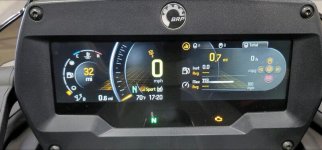broderp
New member
I track all expenses for my vehicles including gas fill ups and I noticed something that alarmed me the other day during my very first fill up at the gas station.
I was scrolling through the menus to see what statistics the Spyder tracks so I could start tracking them. I noticed that according to the Trip "A" stats tab on the dash that my vehicle had apparently been ran at 113 mph! :cus:
I know it wasn't me, the fastest I've rode so far is 63 mph. Looking at the "Totals" tab on the dash (that can't be cleared out) I saw the exact same thing. So I went back to the pictures i took at the dealer before I bought it and found in a video I took as i was randomly playing with the dash and controls that the 113 mph was there since day one. Attached is a screenshot of the dash clearly showing the 113 mph Max speed at only 0.7 miles!
Does anyone know if this is normal? Does Can-Am test Spyder's on a dyno or something during manufacturing or did someone actually ride my Spyder to 113mph on a new engine with less than one mile on it?
In the motorcycle and auto world, there are two schools of thought - break an engine in slowly or run it ragged when new. I don't believe in the latter and this is somewhat upsetting to see this on my new Spyder. Imagine the problems I could run into with warranty if for some reason my engine burns up and Can-am or dealer say its not covered because I ran it before it was broke in or something crazy. :gaah:
Any thoughts on this? Has anyone else seen or this on their new Spyder's?
:cheers:
I was scrolling through the menus to see what statistics the Spyder tracks so I could start tracking them. I noticed that according to the Trip "A" stats tab on the dash that my vehicle had apparently been ran at 113 mph! :cus:
I know it wasn't me, the fastest I've rode so far is 63 mph. Looking at the "Totals" tab on the dash (that can't be cleared out) I saw the exact same thing. So I went back to the pictures i took at the dealer before I bought it and found in a video I took as i was randomly playing with the dash and controls that the 113 mph was there since day one. Attached is a screenshot of the dash clearly showing the 113 mph Max speed at only 0.7 miles!
Does anyone know if this is normal? Does Can-Am test Spyder's on a dyno or something during manufacturing or did someone actually ride my Spyder to 113mph on a new engine with less than one mile on it?
In the motorcycle and auto world, there are two schools of thought - break an engine in slowly or run it ragged when new. I don't believe in the latter and this is somewhat upsetting to see this on my new Spyder. Imagine the problems I could run into with warranty if for some reason my engine burns up and Can-am or dealer say its not covered because I ran it before it was broke in or something crazy. :gaah:
Any thoughts on this? Has anyone else seen or this on their new Spyder's?
:cheers:
Attachments
Last edited:

